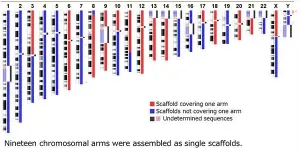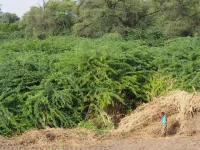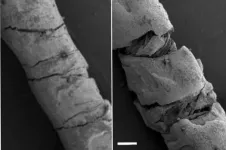An ancient economy
Archaeologist argues the Chumash Indians were using highly worked shell beads as currency 2,000 years ago
2021-01-29
(Press-News.org) As one of the most experienced archaeologists studying California's Native Americans, Lynn Gamble(link is external) knew the Chumash Indians had been using shell beads as money for at least 800 years.
But an exhaustive review(link is external) of some of the shell bead record led the UC Santa Barbara professor emerita of anthropology to an astonishing conclusion: The hunter-gatherers centered on the Southcentral Coast of Santa Barbara were using highly worked shells as currency as long as 2,000 years ago.
"If the Chumash were using beads as money 2,000 years ago," Gamble said, "this changes our thinking of hunter-gatherers and sociopolitical and economic complexity. This may be the first example of the use of money anywhere in the Americas at this time."
Although Gamble has been studying California's indigenous people since the late 1970s, the inspiration for her research on shell bead money came from far afield: the University of Tübingen in Germany. At a symposium there some years ago, most of the presenters discussed coins and other non-shell forms of money. Some, she said, were surprised by the assumptions of California archaeologists about what constituted money.
Intrigued, she reviewed the definitions and identifications of money in California and questioned some of the long-held beliefs. Her research led to "The origin and use of shell bead money in California" in the Journal of Anthropological Archaeology.
Gamble argues that archaeologists should use four criteria in assessing whether beads were used for currency versus adornment: Shell beads used as currency should be more labor-intensive than those for decorative purposes; highly standardized beads are likely currency; bigger, eye-catching beads were more likely used as decoration; and currency beads are widely distributed.
"I then compared the shell beads that had been accepted as a money bead for over 40 years by California archaeologists to another type that was widely distributed," she said. "For example, tens of thousands were found with just one individual up in the San Francisco Bay Area. This bead type, known as a saucer bead, was produced south of Point Conception and probably on the northern [Santa Barbara] Channel Islands, according to multiple sources of data, at least most, if not all of them.
"These earlier beads were just as standardized, if not more so, than those that came 1,000 years later," Gamble continued. "They also were traded throughout California and beyond. Through sleuthing, measurements and comparison of standardizations among the different bead types, it became clear that these were probably money beads and occurred much earlier than we previously thought."
As Gamble notes, shell beads have been used for over 10,000 years in California, and there is extensive evidence for the production of some of these beads, especially those common in the last 3,000 to 4,000 years, on the northern Channel Islands. The evidence includes shell bead-making tools, such as drills, and massive amounts of shell bits -- detritus -- that littered the surface of archaeological sites on the islands.
In addition, specialists have noted that the isotopic signature of the shell beads found in the San Francisco Bay Area indicate that the shells are from south of Point Conception.
"We know that right around early European contact," Gamble said, "the California Indians were trading for many types of goods, including perishable foods. The use of shell beads no doubt greatly facilitated this wide network of exchange."
Gamble's research not only resets the origins of money in the Americas, it calls into question what constitutes "sophisticated" societies in prehistory. Because the Chumash were non-agriculturists -- hunter-gatherers -- it was long held that they wouldn't need money, even though early Spanish colonizers marveled at extensive Chumash trading networks and commerce.
Recent research(link is external) on money in Europe during the Bronze Age suggests it was used there some 3,500 years ago. For Gamble, that and the Chumash example are significant because they challenge a persistent perspective among economists and some archaeologists that so-called "primitive" societies could not have had "commercial" economies.
"Both the terms 'complex' and 'primitive' are highly charged, but it is difficult to address this subject without avoiding those terms," she said. "In the case of both the Chumash and the Bronze Age example, standardization is a key in terms of identifying money. My article on the origin of money in California is not only pushing the date for the use of money back 1,000 years in California, and possibly the Americas, it provides evidence that money was used by non-state level societies, commonly identified as 'civilizations.' "
INFORMATION:
ELSE PRESS RELEASES FROM THIS DATE:
2021-01-29
As part of standard patient protocol, doctors inform women of the risks of pregnancy. But there is one exception to this standard: stillbirth.
University of Arkansas law professor Jill Wieber Lens argues that women have a right to know of the risk of stillbirth, and, consistent with the evolution of informed consent law, this right should be enforceable through a medical malpractice tort claim.
Stillbirth, or pregnancy loss after 20 weeks but before birth, is not uncommon. Annually, 26,000 U.S. women give birth to a stillborn baby, or roughly one out every 160 pregnancies. The United States' stillbirth rate ...
2021-01-29
COLLEGE PARK, Md.--The amount of methane released into the atmosphere as a result of coal mining is likely much higher than previously calculated, according to research presented at the annual meeting of the American Geophysical Union recently.
The study estimates that methane emissions from coal mines are approximately 50 percent higher than previously estimated. The research was done by a team at the U.S. Department of Energy's Pacific Northwest National Laboratory, the U.S. Environmental Protection Agency and others.
The higher estimate is due mainly to two factors: methane that continues to be emitted from thousands of abandoned mines and the higher methane content in coal seams that are ever deeper, according to chief ...
2021-01-29
The Japanese now have their own reference genome thanks to researchers at Tohoku University who completed and released the first Japanese reference genome (JG1).
Their study was published in the journal Nature Communications on January 11, 2021.
"JG1 can aid with the clinical sequence analysis of Japanese individuals with rare diseases as it eliminates the genomic differences from the international reference genome," said Jun Takayama, co-author of the study.
Back in 2003, the Human Genome Project, through a gargantuan global effort, cracked the code of life and mapped all the genes of the human genome.
Since then, more accurate versions of the human reference genome have ...
2021-01-29
The researchers of the Institute for Atmospheric and Earth system research at the University of Helsinki have investigated how atmospheric particles are formed in the Arctic. Until recent studies, the molecular processes of particle formation in the high Arctic remained a mystery.
During their expeditions to the Arctic, the scientists collected measurements for 12 months in total. The results of the extensive research project were recently published in the Geophysical Research Letters journal.
The researchers discovered that atmospheric vapors, particles, and cloud formation have clear differences within various Arctic environments. The study clarifies how Arctic warming and sea ice loss strengthens processes where different vapors are emitted to the atmosphere. The ...
2021-01-29
The Covid-19 pandemic has made home offices, virtual meetings and remote learning the norm, and it is likely here to stay. But are people paying attention in online meetings? Are students paying attention in virtual classrooms? Researchers Jens Madsen and Lucas C. Parra from City College of New York, demonstrate how eye tracking can be used to measure the level of attention online using standard web cameras, without the need to transfer any data from peoples computers, thus preserving privacy. In a paper entitled "Synchronized eye movements predict test scores in online video education," published in the Proceedings of the National Academy of Sciences, they show that just ...
2021-01-29
Scientists at Johannes Gutenberg University Mainz (JGU) and ETH Zurich have developed a process to produce commodity chemicals in a much less hazardous way than was previously possible. Such commodity chemicals represent the starting point for many mass-produced products in the chemical industry, such as plastics, dyes, and fertilizers, and are usually synthesized with the help of chlorine gas or bromine, both of which are extremely toxic and highly corrosive. In the current issue of Science, the researchers report that they have been able to utilize electrolysis, i.e., the application of an electric current, to obtain chemicals known as dichloro and dibromo compounds, which can then be used to synthesize ...
2021-01-29
A new study has found that mobile apps can play a vital role in helping immigrants integrate into new cultures, as well as provide physical and mental health benefits.
Researchers at Anglia Ruskin University (ARU) surveyed new migrants and refugees undertaking free beginners' language classes in Greece, often the first destination for people arriving into Europe from Africa and Asia, over a 10-month period.
The findings, published in the journal Computers in Human Behavior, show that those using mobile apps aided by artificial intelligence (AI), such as language assistants, customised information sites, or health symptom trackers, experienced ...
2021-01-29
New research has revealed how an invasion of the alien evergreen tree, Prosopis juliflora seriously diminishes water resources in the Afar Region of Ethiopia, consuming enough of this already scarce resource to irrigate cotton and sugarcane generating some US$ 320 million and US$ 470 million net benefits per year.
A team of Ethiopian, South African and Swiss scientists, including lead author Dr Hailu Shiferaw, Dr Tena Alamirew, and Dr Gete Zeleke from the Water and Land Resource Centre of Addis Ababa University, Ethiopia, and Dr Sebinasi Dzikiti from Stellenbosch University, ...
2021-01-29
Scientists have broadened our understanding of how 'weak' cells bond with their more mature cellular counterparts to boost the body's production of insulin, improving our knowledge of the processes leading to type 2 diabetes - a significant global health problem.
Type 2 diabetes mellitus occurs when β-cells cannot release enough insulin - a tightly controlled process requiring hundreds of such cells clustered together to co-ordinate their response to signals from food, such as sugar, fat and gut hormones.
An international research team - led by scientists at the University of ...
2021-01-29
Engineers at Tufts University have created and demonstrated flexible thread-based sensors that can measure movement of the neck, providing data on the direction, angle of rotation and degree of displacement of the head. The discovery raises the potential for thin, inconspicuous tatoo-like patches that could, according to the Tufts team, measure athletic performance, monitor worker or driver fatigue, assist with physical therapy, enhance virtual reality games and systems, and improve computer generated imagery in cinematography. The technology, described today in Scientific Reports, adds to a growing number of thread-based ...
LAST 30 PRESS RELEASES:
[Press-News.org] An ancient economy
Archaeologist argues the Chumash Indians were using highly worked shell beads as currency 2,000 years ago





